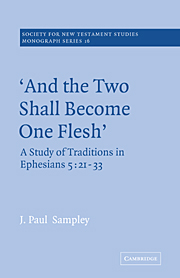Book contents
- Frontmatter
- Contents
- Dedication
- Preface
- Acknowledgments
- I Introduction of problem and perspective
- II Outline of the epistle to the Ephesians and the author's knowledge of his readers
- III Identification and study of traditional materials in 5: 21–33
- IV Three passages from the homologoumena especially related to 5: 21–33
- V Hermeneutical problems in 5: 31–2
- VI The movement of thought in 5: 21–33
- VII Detailed analysis of 5: 21–33
- VIII Concluding observations
- Bibliography
- Indexes (passages cited, authors, subjects, selected Greek words)
III - Identification and study of traditional materials in 5: 21–33
Published online by Cambridge University Press: 29 September 2009
- Frontmatter
- Contents
- Dedication
- Preface
- Acknowledgments
- I Introduction of problem and perspective
- II Outline of the epistle to the Ephesians and the author's knowledge of his readers
- III Identification and study of traditional materials in 5: 21–33
- IV Three passages from the homologoumena especially related to 5: 21–33
- V Hermeneutical problems in 5: 31–2
- VI The movement of thought in 5: 21–33
- VII Detailed analysis of 5: 21–33
- VIII Concluding observations
- Bibliography
- Indexes (passages cited, authors, subjects, selected Greek words)
Summary
In previous studies of Eph. 5: 21–33, the identification of and concern with traditional materials have focused primarily on two matters: (1) the extent and importance of the Haustafel form, and, more often, (2) the assessment of that part of 5: 21–33 often spoken of as the hieros gamos or ‘Bride of Christ’.
Studies of the imagery having to do with the hieros gamos usually converge on 5: 25–7, with occasional brief mention of other pertinent verses in 5: 21–33. Books and monographs that treat of this subject are numerous. Illustrative of one such approach to the examination of Eph. 5: 21–33 are the relevant sections of Claude Chavasse's book, The Bride of Christ, and Paul S. Minear's work, Images of the Church in the New Testament. Such studies have their own function as dogmatic considerations of a problem that appears in some of the NT writings. They do, however, leave open the question of the importance of contextual considerations and the larger problem of the function of such imagery in the epistle as a whole.
Other studies treat the hieros gamos from a religionsgeschichtliche perspective. Of greatest significance from this standpoint is the section in Heinrich Schlier's commentary, Der Brief an die Epheser, in which he devotes several pages to a study of the hieros gamos in Ephesians as seen against his reconstruction of its background.
- Type
- Chapter
- Information
- 'And The Two Shall Become One Flesh'A Study of Traditions in Ephesians 5: 21-33, pp. 16 - 76Publisher: Cambridge University PressPrint publication year: 1971



